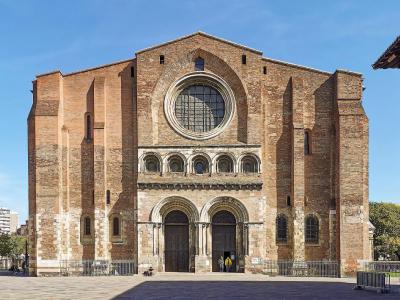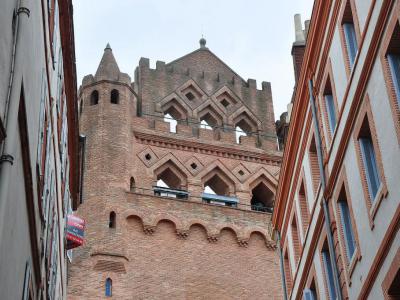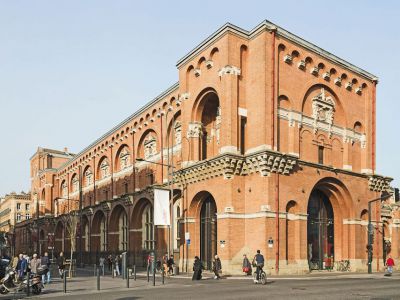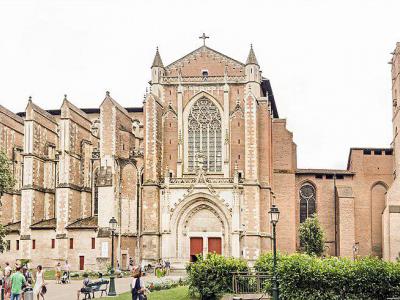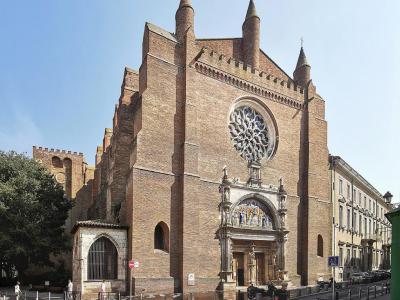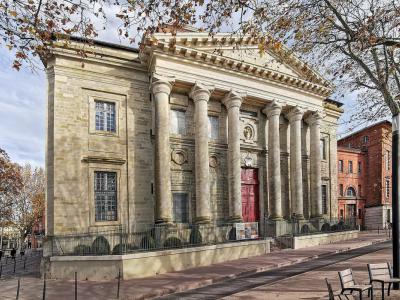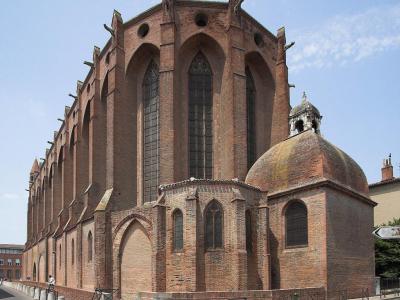Historical Churches Tour (Self Guided), Toulouse
Toulouse's historical center is full of architectural marvels, many of which are churches. The variety of basilicas, cathedrals, and cloisters built in the city throughout the 11th-19th centuries is complemented by the richness of styles serving as a testament to both faith and craftsmanship.
The 12th-century Basilica of Saint Sernin is a masterpiece of Romanesque design. It's known for its stunning interior and the relics of Saint Saturnin, the city's first bishop, making it a significant pilgrimage site.
Notre-Dame du Taur Church is dedicated to the Virgin Mary and boasts a beautiful Gothic facade. It's said to be built on the site where Saint Saturnin was martyred.
The Augustine Convent complex, dating back to the 14th century, once played a significant role in the city's religious and cultural history. Today, it elegantly contributes to the cityscape with its serene courtyard.
Meanwhile, the grand Toulouse Cathedral (Cathédrale Saint-Étienne de Toulouse) showcases a blend of Gothic, Baroque, and Romanesque, and is a magnificent piece of ecclesiastical masonry, adorned with impressive stained glass windows.
Another local gem, albeit smaller, is the Notre-Dame de la Dalbade Church, featuring a blend of Gothic and Renaissance styles, with intricately carved details on the facade.
Notre-Dame de la Daurade Church, situated along the Garonne River, once known for its stunning golden mosaics (hence the name Daurade), is rich in history, including being the site of a former Roman temple.
Finally, the Jacobins' Church, a masterpiece of Southern Gothic architecture, is famous for its stunning palm-shaped vaulted ceiling and is the final resting place of Saint Thomas Aquinas.
Apart from their religious significance, these historical churches offer a glimpse into Toulouse's architectural and cultural heritage. Exploring these landmarks is a journey through time and a chance to appreciate the city's spiritual and artistic legacy.
The 12th-century Basilica of Saint Sernin is a masterpiece of Romanesque design. It's known for its stunning interior and the relics of Saint Saturnin, the city's first bishop, making it a significant pilgrimage site.
Notre-Dame du Taur Church is dedicated to the Virgin Mary and boasts a beautiful Gothic facade. It's said to be built on the site where Saint Saturnin was martyred.
The Augustine Convent complex, dating back to the 14th century, once played a significant role in the city's religious and cultural history. Today, it elegantly contributes to the cityscape with its serene courtyard.
Meanwhile, the grand Toulouse Cathedral (Cathédrale Saint-Étienne de Toulouse) showcases a blend of Gothic, Baroque, and Romanesque, and is a magnificent piece of ecclesiastical masonry, adorned with impressive stained glass windows.
Another local gem, albeit smaller, is the Notre-Dame de la Dalbade Church, featuring a blend of Gothic and Renaissance styles, with intricately carved details on the facade.
Notre-Dame de la Daurade Church, situated along the Garonne River, once known for its stunning golden mosaics (hence the name Daurade), is rich in history, including being the site of a former Roman temple.
Finally, the Jacobins' Church, a masterpiece of Southern Gothic architecture, is famous for its stunning palm-shaped vaulted ceiling and is the final resting place of Saint Thomas Aquinas.
Apart from their religious significance, these historical churches offer a glimpse into Toulouse's architectural and cultural heritage. Exploring these landmarks is a journey through time and a chance to appreciate the city's spiritual and artistic legacy.
How it works: Download the app "GPSmyCity: Walks in 1K+ Cities" from Apple App Store or Google Play Store to your mobile phone or tablet. The app turns your mobile device into a personal tour guide and its built-in GPS navigation functions guide you from one tour stop to next. The app works offline, so no data plan is needed when traveling abroad.
Historical Churches Tour Map
Guide Name: Historical Churches Tour
Guide Location: France » Toulouse (See other walking tours in Toulouse)
Guide Type: Self-guided Walking Tour (Sightseeing)
# of Attractions: 7
Tour Duration: 2 Hour(s)
Travel Distance: 3.2 Km or 2 Miles
Author: helenp
Sight(s) Featured in This Guide:
Guide Location: France » Toulouse (See other walking tours in Toulouse)
Guide Type: Self-guided Walking Tour (Sightseeing)
# of Attractions: 7
Tour Duration: 2 Hour(s)
Travel Distance: 3.2 Km or 2 Miles
Author: helenp
Sight(s) Featured in This Guide:
- Basilica of Saint Sernin
- Notre-Dame du Taur Church
- Augustine Convent
- Cathédrale Saint-Étienne de Toulouse (Toulouse Cathedral)
- Notre-Dame de la Dalbade Church
- Notre-Dame de la Daurade Church
- Church of the Jacobins
1) Basilica of Saint Sernin (must see)
The Basilica of Saint-Sernin in Toulouse is a historic church located on the site of a previous basilica of the 4th century which contained the body of Saint Sernin, the first bishop of Toulouse around the year 250. Noted for its exceptional Romanesque sculpture, the church was designated a UNESCO World Heritage Site in 1998 as part of the Routes of Saint James in France.
The original basilica, initiated by Saint Sylvius in the 4th century, was part of the Abbey of Saint Sernin and gained prominence after King Charlemagne's donation of relics, making it a key pilgrimage site.
The current basilica – featuring Romanesque style – was built in the early 12th century. Its construction continued over the centuries with many fits and starts and is estimated to have comprised at least four major building undertakings. Curiously enough, 19th-century restorations are now being reversed to preserve the church's original design.
Although called “basilica”, Saint-Sernin diverges from traditional early Christian basilica plans, incorporating features of the so-called "pilgrimage plan." Notably larger than its predecessors, at 104 meters long, and predominantly built of brick, its design includes a cruciform shape and vaulted ceilings. Unlike earlier churches, Saint-Sernin features an ambulatory and radiating chapels that house important relics, allowing visitors to view them without disrupting ongoing masses.
The basilica's exterior is marked by a bell tower with Romanesque arches from the 12th century and a 15th-century spire. Key external features include the Comtes Gate and the elaborately sculpted Miegeville Gate. Internally, the vast space is structured with a barrel-vaulted nave and rib-vaulted aisles. The basilica also houses a significant Cavaillé-Coll organ, among France's most important.
Tips:
While there is no admission charge, donations are welcome.
The original basilica, initiated by Saint Sylvius in the 4th century, was part of the Abbey of Saint Sernin and gained prominence after King Charlemagne's donation of relics, making it a key pilgrimage site.
The current basilica – featuring Romanesque style – was built in the early 12th century. Its construction continued over the centuries with many fits and starts and is estimated to have comprised at least four major building undertakings. Curiously enough, 19th-century restorations are now being reversed to preserve the church's original design.
Although called “basilica”, Saint-Sernin diverges from traditional early Christian basilica plans, incorporating features of the so-called "pilgrimage plan." Notably larger than its predecessors, at 104 meters long, and predominantly built of brick, its design includes a cruciform shape and vaulted ceilings. Unlike earlier churches, Saint-Sernin features an ambulatory and radiating chapels that house important relics, allowing visitors to view them without disrupting ongoing masses.
The basilica's exterior is marked by a bell tower with Romanesque arches from the 12th century and a 15th-century spire. Key external features include the Comtes Gate and the elaborately sculpted Miegeville Gate. Internally, the vast space is structured with a barrel-vaulted nave and rib-vaulted aisles. The basilica also houses a significant Cavaillé-Coll organ, among France's most important.
Tips:
While there is no admission charge, donations are welcome.
2) Notre-Dame du Taur Church
Notre-Dame du Taur is a Roman Catholic church steeped in history and legend, situated in the heart of Toulouse. This historic church designated a monument since 1840, lies on Taur Street (Rue du Taur), strategically positioned between the Capitole and the Basilica of Saint Sernin. It marks the spot where, according to tradition, the body of Saint Saturnin, the first bishop of Toulouse and the city's patron saint, was detached from the bull that dragged him to his death-a dramatic act of martyrdom occurring around 250 AD.
The church's name, Notre Dame du Taur, carries rich symbolism from its history. "Notre Dame," linked to Mary, emphasizes its dedication to her after a statue was moved there in 1783. "Taur," reflecting the Latin word for bull, "Taurus," represents Saint Saturnin's martyrdom tool. Initially, Saint Sernin, related to Saturnin, was a crucial stop for pilgrims going to Santiago de Compostela, vital in medieval religious journeys.
Constructed between the 14th and 16th centuries, Notre-Dame du Taur showcases the Southern French Gothic architectural style, characterized by its modest, less ornate aesthetics compared to its Northern counterparts. The façade features a cloche-mur (bell tower wall), a common architectural element in the region, flanked by small hexagonal towers and adorned with crenelations.
The church's interior is marked by a single aisle capped with a ribbed vault, leading to a transept that opens into two apsidal chapels at the eastern end. It houses significant artworks, including a 19th-century painting by Toulouse artist Bernard Bénézet depicting the martyrdom of Saint Saturnin and the Glorification of the Virgin. Other notable pieces include a Death of Saint Joseph and additional paintings representing Saturnin's martyrdom, as well as a 14th-century genealogy of Saint Joseph.
Central to the church's spiritual life is the wooden statue of Mary, positioned in the center of the apse, making it a focal point upon entry. This statue, alongside other sacred relics like the Pieta in the north chapel and a statue of Saint Anne in the south chapel, enriches the church's religious and artistic heritage.
The church's name, Notre Dame du Taur, carries rich symbolism from its history. "Notre Dame," linked to Mary, emphasizes its dedication to her after a statue was moved there in 1783. "Taur," reflecting the Latin word for bull, "Taurus," represents Saint Saturnin's martyrdom tool. Initially, Saint Sernin, related to Saturnin, was a crucial stop for pilgrims going to Santiago de Compostela, vital in medieval religious journeys.
Constructed between the 14th and 16th centuries, Notre-Dame du Taur showcases the Southern French Gothic architectural style, characterized by its modest, less ornate aesthetics compared to its Northern counterparts. The façade features a cloche-mur (bell tower wall), a common architectural element in the region, flanked by small hexagonal towers and adorned with crenelations.
The church's interior is marked by a single aisle capped with a ribbed vault, leading to a transept that opens into two apsidal chapels at the eastern end. It houses significant artworks, including a 19th-century painting by Toulouse artist Bernard Bénézet depicting the martyrdom of Saint Saturnin and the Glorification of the Virgin. Other notable pieces include a Death of Saint Joseph and additional paintings representing Saturnin's martyrdom, as well as a 14th-century genealogy of Saint Joseph.
Central to the church's spiritual life is the wooden statue of Mary, positioned in the center of the apse, making it a focal point upon entry. This statue, alongside other sacred relics like the Pieta in the north chapel and a statue of Saint Anne in the south chapel, enriches the church's religious and artistic heritage.
3) Augustine Convent
The Augustinian Convent, located in the heart of Toulouse, and fronting on Metz Street (Rue de Metz), has a rich history dating back to its foundation in 1269. Originally established for a community of Hermits of Saint Augustine outside the city walls, the convent relocated to its current central location in 1310 after receiving permission from Pope Clement V. This "new" site saw the construction of the convent throughout the 14th century, culminating in the completion of the cloister in 1396.
Despite suffering significant damage during the great fire of Toulouse in May 1463, which necessitated four decades of reconstruction, the convent was rededicated in 1504 and remained a flourishing religious community until its gradual decline over the next few centuries. In November 1789, following the French Revolution, the convent was nationalized, and by August 1795, it was repurposed as the Toulouse Museum of Art.
Today, the convent's architecture is a prominent example of medieval design, featuring a block-size brick building complex. Visitors enter through Rue de Metz, where a small reception area leads to the impressive cloister. This cloister, complete with long rows of double-column pillars, houses a garden and is surrounded by Romanesque galleries, maintaining much of its original splendor.
The museum's collections are housed primarily on the ground floor, with Romanesque and Gothic sculptures from the 12th, 14th, and 15th centuries, as well as period religious paintings. Notable features include ancient gargoyles from the Cordelier's monastery, displayed along the southern section of the cloister, giving visitors a rare close-up view. The central room of the eastern gallery is particularly striking, with tall slender columns and beautifully arched ceilings.
The museum offers a comprehensive display of fine arts in its galleries, enhancing Toulouse's cultural landscape and preserving its historical heritage within the walls of the former Augustinian Convent.
Despite suffering significant damage during the great fire of Toulouse in May 1463, which necessitated four decades of reconstruction, the convent was rededicated in 1504 and remained a flourishing religious community until its gradual decline over the next few centuries. In November 1789, following the French Revolution, the convent was nationalized, and by August 1795, it was repurposed as the Toulouse Museum of Art.
Today, the convent's architecture is a prominent example of medieval design, featuring a block-size brick building complex. Visitors enter through Rue de Metz, where a small reception area leads to the impressive cloister. This cloister, complete with long rows of double-column pillars, houses a garden and is surrounded by Romanesque galleries, maintaining much of its original splendor.
The museum's collections are housed primarily on the ground floor, with Romanesque and Gothic sculptures from the 12th, 14th, and 15th centuries, as well as period religious paintings. Notable features include ancient gargoyles from the Cordelier's monastery, displayed along the southern section of the cloister, giving visitors a rare close-up view. The central room of the eastern gallery is particularly striking, with tall slender columns and beautifully arched ceilings.
The museum offers a comprehensive display of fine arts in its galleries, enhancing Toulouse's cultural landscape and preserving its historical heritage within the walls of the former Augustinian Convent.
4) Cathédrale Saint-Étienne de Toulouse (Toulouse Cathedral) (must see)
The Cathedral of Saint Stephen, commonly known as the Toulouse Cathedral, is a prominent Roman Catholic church and a national monument, tracing its origins back to the 3rd century. Established by Saint Saturnin, it was later rebuilt by Bishop Saint Exuperius into a Romanesque structure in 1078.
During the early 13th century, the cathedral underwent substantial modifications in the Raymondine Gothic style.
The building suffered a significant fire in 1609, leading to a fundraising effort for its restoration. The French Revolution brought further destruction when the site was sacked and transformed into a "Temple of Reason." Inside, the cathedral was severely destroyed and used as a warehouse for scrap iron. By 1802, Napoleon had made up with the Pope, and the cathedral was returned to the Catholic Church, upon which the City of Toulouse made repairs.
A major restoration in 1911 harmonized the old and new parts of the cathedral, further beautified by a surrounding public garden.
The structure is notable for its irregular facade, resulting from the merger of two incomplete churches from different periods, and its use of brick due to regional stone shortages. The oversized buttresses were formed for a choir much higher than the one that was eventually built. There is also a 16th-century bell tower joined with a donjon of fortress-like proportions. Post-Revolution, all religious bells were melted down. A new set – of 13 bells – was made later on. The largest of them, Etienne-Florian, was cast in 1876 and weighs 3.9 tons.
The cathedral's interior is a source of confusion, featuring contrasting Gothic styles: a large nave originally built in 1078, and a choir from 1272, which are architecturally misaligned. A massive pillar stands between the two sections.
Despite the chaos of its history, however, the cathedral is an island of peace with richly decorated chapels, significant stained glass, and finely carved choir stalls.
Also, the cathedral boasts two organs: the main tribune organ built in 1612, and a smaller choir one from 1868.
During the early 13th century, the cathedral underwent substantial modifications in the Raymondine Gothic style.
The building suffered a significant fire in 1609, leading to a fundraising effort for its restoration. The French Revolution brought further destruction when the site was sacked and transformed into a "Temple of Reason." Inside, the cathedral was severely destroyed and used as a warehouse for scrap iron. By 1802, Napoleon had made up with the Pope, and the cathedral was returned to the Catholic Church, upon which the City of Toulouse made repairs.
A major restoration in 1911 harmonized the old and new parts of the cathedral, further beautified by a surrounding public garden.
The structure is notable for its irregular facade, resulting from the merger of two incomplete churches from different periods, and its use of brick due to regional stone shortages. The oversized buttresses were formed for a choir much higher than the one that was eventually built. There is also a 16th-century bell tower joined with a donjon of fortress-like proportions. Post-Revolution, all religious bells were melted down. A new set – of 13 bells – was made later on. The largest of them, Etienne-Florian, was cast in 1876 and weighs 3.9 tons.
The cathedral's interior is a source of confusion, featuring contrasting Gothic styles: a large nave originally built in 1078, and a choir from 1272, which are architecturally misaligned. A massive pillar stands between the two sections.
Despite the chaos of its history, however, the cathedral is an island of peace with richly decorated chapels, significant stained glass, and finely carved choir stalls.
Also, the cathedral boasts two organs: the main tribune organ built in 1612, and a smaller choir one from 1868.
5) Notre-Dame de la Dalbade Church
In 410 the Emperor Honorius allowed the conversion of pagan temples within the empire. And so the Temple of Apollo in the city of Tolosa was converted to Christianity. The new church was the original Notre-Dame de la Dalbade. It was replaced in 541 by another Notre-Dame, which served faithfully until burning down in 1442.
The present Notre Dame also served faithfully without serious incident until 1926, when its tower collapsed, destroying much of the church and killing two unlucky bakers on their way to work. The interior was restored. And then Toulouse had a 15th century church with a 20th century inside. The tower was never replaced, which may be a good thing.
Over the entrance is a renaissance tympanum with a copy of Fra Angelico's Coronation of the Virgin. The second Notre Dame was covered with lime. This resulted in a vision of pure whiteness. Many felt this effect was a tribute to the Virgin Mother. After the fire of 1442 the outside was rebuilt with the red brick of Toulouse. Now it was red outside.
Inside, outside, 15th century, 20th century, red, white, in spite of all this, the church stands. The colorful Italian-Renaissance entrance welcoming all who enter. Apollo would have been pleased.
The present Notre Dame also served faithfully without serious incident until 1926, when its tower collapsed, destroying much of the church and killing two unlucky bakers on their way to work. The interior was restored. And then Toulouse had a 15th century church with a 20th century inside. The tower was never replaced, which may be a good thing.
Over the entrance is a renaissance tympanum with a copy of Fra Angelico's Coronation of the Virgin. The second Notre Dame was covered with lime. This resulted in a vision of pure whiteness. Many felt this effect was a tribute to the Virgin Mother. After the fire of 1442 the outside was rebuilt with the red brick of Toulouse. Now it was red outside.
Inside, outside, 15th century, 20th century, red, white, in spite of all this, the church stands. The colorful Italian-Renaissance entrance welcoming all who enter. Apollo would have been pleased.
6) Notre-Dame de la Daurade Church
Notre-Dame de la Daurade is a historic basilica located in Toulouse, with a rich history that traces back to the early 5th century. Originally, the site was home to a pagan temple dedicated to Apollo, which was converted into a Christian church around 410 AD, under the authorization of Emperor Honorius. This transformation marked the beginning of the site's Christian heritage.
The name "Daurade" comes from "Deaurata," referring to the golden mosaics that adorned the church built during the 5th or 6th century. These mosaics, accompanied by inscriptions, indicate that the church initially served the Visigoths who practiced Arian Christianity. The church shifted into Catholic hands after the Visigoths were defeated at the Battle of Vouillé in 507.
By the 9th century, Notre-Dame de la Daurade had become a Benedictine monastery. However, it experienced a decline starting in the 15th century and was eventually demolished in 1761 to facilitate the construction of riverside quays in Toulouse. The site saw further transformation during the French Revolution when the monastery was closed and repurposed as a tobacco factory.
The basilica was historically significant for housing a shrine of the Black Madonna, an icon highly revered in the Christian community. The original icon was stolen in the 15th century, and its subsequent replacement was destroyed during the Revolution. Today's icon, created in 1807, is a replica of the 15th-century Madonna and has been significantly darkened by candle soot over the years, earning it the name "Notre Dame The Black" ("Notre Dame La Noire").
Reconstruction of the current basilica structure took place in the 19th century. The church, along with its notable organ, has been officially listed as a Monument historique by the French Ministry of Culture, underscoring its cultural and historical importance to the region and France's heritage.
The name "Daurade" comes from "Deaurata," referring to the golden mosaics that adorned the church built during the 5th or 6th century. These mosaics, accompanied by inscriptions, indicate that the church initially served the Visigoths who practiced Arian Christianity. The church shifted into Catholic hands after the Visigoths were defeated at the Battle of Vouillé in 507.
By the 9th century, Notre-Dame de la Daurade had become a Benedictine monastery. However, it experienced a decline starting in the 15th century and was eventually demolished in 1761 to facilitate the construction of riverside quays in Toulouse. The site saw further transformation during the French Revolution when the monastery was closed and repurposed as a tobacco factory.
The basilica was historically significant for housing a shrine of the Black Madonna, an icon highly revered in the Christian community. The original icon was stolen in the 15th century, and its subsequent replacement was destroyed during the Revolution. Today's icon, created in 1807, is a replica of the 15th-century Madonna and has been significantly darkened by candle soot over the years, earning it the name "Notre Dame The Black" ("Notre Dame La Noire").
Reconstruction of the current basilica structure took place in the 19th century. The church, along with its notable organ, has been officially listed as a Monument historique by the French Ministry of Culture, underscoring its cultural and historical importance to the region and France's heritage.
7) Church of the Jacobins (must see)
The Dominican Order had their first convent in Paris on the Saint-Jacques Street. Jaques of course, means "James" and James in Latin is "Jacobus". So the Dominicans were popularly known as "Jacobins." Saint Dominic founded his order in 1215 in Toulouse.
In 1215 the province of Occitan was home to the Cathars, a christian sect thought to be heretical. Dominic hoped to combat this heresy by establishing a preaching brotherhood of monks. In 1230 the Dominican friars began the construction of a small church in Toulouse from which to preach.
Over the centuries the church grew and expanded. A choir, side chapels and a vaulted roof were added. Saint Thomas Acquinas, a dominican monk who was canonized in 1323, was interred in the church by order of Pope Urban V in 1368. During the French Revolution the remains were moved to Saint Sernin's. They were returned in 1974.
The emperor Napoleon requisitioned the church for a barracks in 1810. The Dominicans had already been forced to leave in 1789. The inside of the church was gutted, floors were put in, stained glass windows destroyed and covered over. Popular revulsion eventually forced the Army to move out in 1861. Restoration began and the church became a museum.
The Church of the Jacobins is in the center of town. Take the metro to the Capitole station and walk west. It is a 5 minute journey by foot. There is a small entrance fee to enter the church.
In 1215 the province of Occitan was home to the Cathars, a christian sect thought to be heretical. Dominic hoped to combat this heresy by establishing a preaching brotherhood of monks. In 1230 the Dominican friars began the construction of a small church in Toulouse from which to preach.
Over the centuries the church grew and expanded. A choir, side chapels and a vaulted roof were added. Saint Thomas Acquinas, a dominican monk who was canonized in 1323, was interred in the church by order of Pope Urban V in 1368. During the French Revolution the remains were moved to Saint Sernin's. They were returned in 1974.
The emperor Napoleon requisitioned the church for a barracks in 1810. The Dominicans had already been forced to leave in 1789. The inside of the church was gutted, floors were put in, stained glass windows destroyed and covered over. Popular revulsion eventually forced the Army to move out in 1861. Restoration began and the church became a museum.
The Church of the Jacobins is in the center of town. Take the metro to the Capitole station and walk west. It is a 5 minute journey by foot. There is a small entrance fee to enter the church.
Walking Tours in Toulouse, France
Create Your Own Walk in Toulouse
Creating your own self-guided walk in Toulouse is easy and fun. Choose the city attractions that you want to see and a walk route map will be created just for you. You can even set your hotel as the start point of the walk.
Toulouse Introduction Walking Tour
Known affectionately as "The Pink City" (La Ville Rose) due to the terracotta bricks used in many of its buildings, the capital of the Occitania region of France – Toulouse – offers a blend of historical intrigue and modern dynamism. Originally known as Tolosa (the meaning of the name is unknown), it was established as a military outpost by the Romans in the 2nd century BC.
... view more
Tour Duration: 2 Hour(s)
Travel Distance: 3.1 Km or 1.9 Miles
... view more
Tour Duration: 2 Hour(s)
Travel Distance: 3.1 Km or 1.9 Miles
Architectural Jewels of Toulouse
It doesn't take an architectural expert to appreciate the beauty of Toulouse's historic buildings. Walking the city's streets one can't help admiring the galore of ancient architecture which has earned Toulouse, since as early as the 16th century, the title of "the most beautiful city in France".
Once a powerful provincial capital, Toulouse utilized its prosperity,... view more
Tour Duration: 2 Hour(s)
Travel Distance: 3.8 Km or 2.4 Miles
Once a powerful provincial capital, Toulouse utilized its prosperity,... view more
Tour Duration: 2 Hour(s)
Travel Distance: 3.8 Km or 2.4 Miles
Toulouse Markets and Shopping Streets
Like many other cities in France and Southern France in particular, Toulouse boasts a delightful array of shopping areas. At Galeries Lafayette, a renowned department store, you can find exclusive French items for sale - no problem; however, to discover some truly great bargains – from organic vegetables to antiques, – a visit to Toulouse's street markets is a must.
One of the most... view more
Tour Duration: 1 Hour(s)
Travel Distance: 1.2 Km or 0.7 Miles
One of the most... view more
Tour Duration: 1 Hour(s)
Travel Distance: 1.2 Km or 0.7 Miles
Useful Travel Guides for Planning Your Trip
Pub Crawl of Toulouse
There are some really great little pubs in Toulouse. This guide helps you find a few of the local favourites, one pint after the other. Discover good craic at Mulligans and The Killarney; be amazed at what's on tap at Bar l'Ancienne Belgique and Bar La Tireuse; and put the English back in...
The Most Popular Cities
/ view all



